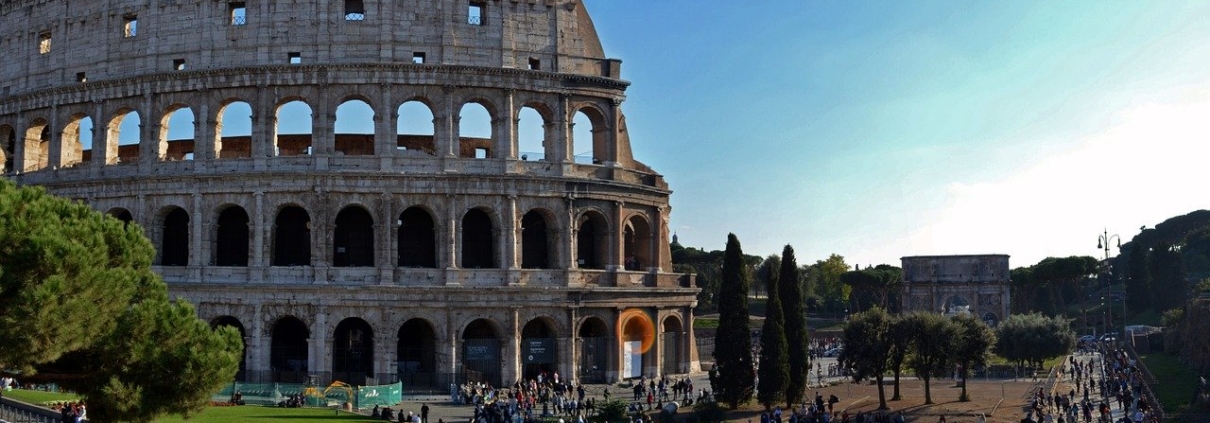What & where to eat in Rome: Colosseum
Looking for the best restaurants near the Colosseum, where to eat and what? here you are
What and where to eat: restaurants near Colosseum
This is one of the most suggestive and romantic areas of Rome, so my advice is, at least once, to have dinner here, even if probably it will cost a little bit more than other areas.
Colosseum area is very popular amongst roman citizen as an area to chill out. Firstly, few steps over the hill of Colle Oppio, there is Monti quarter. This is one of the most favorite destinations for Happy hour or to dine in the best restaurants near by. Secondly, behind the Tram railways, left side of the Underground stop, you’ll find a lively number of bars some of them raimbow style. Thirdly, walking towards Circus Maximum, there is a number of places where to eat and drink.
Via dei Fori Imperiali, is the long avenue connecting Colosseum to Piazza Venezia, site of the “Vittoriano” and geographical centre of the city. It is nice to walk along this avenue admiring ancient Roman Forum from above and the amazing Mercati Traianei.
There are three amazing restaurants (and not too expensive), just few steps from the Colosseum:
Le Terme del Colosseo (Via del Cardello 13), where you can have a lovely dinner with entertainment, because sometimes they have singers or bands playing music at dinner time;
Hostaria Isidoro al Colosseo (Via di San Giovanni in Laterano 59/A), one of the most famous restaurant in Rome where you can taste the real roman culinary tradition in all the recipes;
Naumachia (Via Celimontana 7), a very nice place famous for their pizza and their antipasti (you should try the supplì or the parmigiana!).
As always, since you’re going to be in the most famous country in the world for gelato and caffè,have a look on following bars and gelaterie.
Oppio Caffè (Via delle Terme di Tito 72) is one of the best places around the Colosseum for aperitif, and they have some tables outside just in front of the Colosseum itself, so you even have an amazing view. Please always remember that when you sit outside, especially in front of monuments or big squares, you may pay an extra charge;
Black Market (Via Panisperna 101), amazing location, great atmosphere, specialized in cocktails.Live music and beer.
A couple of good gelaterie of the district
La Dolce Vita (Via Cavour 306), try their wild fruits and yogurt
Cremeria Don Pepe (Via di San Giovanni in Laterano 40).
Fatamorgana Monti (Piazza degli Zingari, 5)
Grezzo (Via Urbana 36)
Best Happy Hour places for Aperitivo:
Divinostilia – (Via Ostilia)
Caffè propaganda ( Via Claudia 15)
Coming out – Via San Giovanni in Laterano 8 (raimbow bar)
Ai tre Scalini – (Via Panisperna 251)
Barzilai (Via Panisperna 44)
Al Vino Al Vino (Via dei Serpenti 19)
Charity Cafè (Via Panisperna 68)
A little bit of history: the Colosseum
The site chosen was a flat area on the floor of a low valley between the Caelian, Esquiline and Palatine Hills, through which a canalized stream ran.
In contrast to many other amphitheaters, on the outskirts of a city, the Colosseum was constructed in the city center. In other words, directly in the heart of the city.
Gladiatorial schools and other support buildings were nearby within the former grounds of the Domus Aurea.
Real name is Anfiteatro (amphiteathre) Flavio (Flavian). The name Colosseum seems to be connected with a huge statue (colosso) that was installed at the side of the Building.
Built of travertine limestone, tuff (volcanic rock), and brick-faced concrete. What is visible today is just the skeleton, once it was completely decorated with marble.
Who started the construction?
The Emperor Vespasian in around 70–72 AD approximately. However, Vespasian will never see the end of the works. His son Titus, will finish the top floor in 80 AD, one year after his father’s death.
The inaugural games of the biggest stadium of the world is still today ephical. For almost a year, the inaugural games of the amphitheater entertained people with over 9,000 wild animals killed. Even a commemorative coinage was issued celebrating the inauguration.
The next successor, brother of Titus, Domitian, started some restylings. For example the hypogeum, a series of underground tunnels used to house animals and slaves. He also added a gallery to the top of the Colosseum to increase its seating capacity.
How was the amphitheatre organized?
Average capacity of the amphitheatre was 65000 spectators, a record for Centuries. Amazing was the organization to assist games. Each Spectator was provided with a ticket to access from a specific door and seats were numbered. Certainly seats were organized on a classy order. In case of rain or sun, hundres of expert sailors were ready to cover the rooftop with a system of moving curtains.
In 217, the Colosseum was badly damaged by a major fire which destroyed the wooden upper levels of the amphitheater’s interior. Some other damages due to earthquakes and fires made necessary some other restorations.
Games with animal hunts continued until at least 523, when Anicius Maximus celebrated his consulship with some venationes, criticized by King Theodoric the Great for their high cost.
The Colosseum underwent several radical changes of use during the medieval period.
A small Chapel was built at the end of the 6th century. Then the arena was turned into a cemetery. The numerous vaulted spaces in the arcades under the seating were converted into housing and workshops, and are recorded as still being rented out as late as the 12th century.
Around 1200 the Frangipani family took over the Colosseum and fortified it, apparently using it as a castle.
Around 17th Century the Pope, Sixtus V (the one of the Sistine Chapel) decided to give a new role to the Colosseum. His plan was even to turn the site into a factory to employ prostitutes. This will never happen due to the Pope’s death.
In 1749, Pope Benedict XIV wanted the Colosseum as a sacred site, in memorial of early Christians martyred. However, there is no historical evidence to support Benedict’s claim.
Today.
The Colosseum is today one of Rome’s most popular tourist attractions, receiving millions of visitors annually. Because of the ruined state of the interior, it is impractical to use the Colosseum to host large events. Temporary seating for events hosts only a few hundred spectators. However, much larger concerts take place just outside, using the Colosseum as a backdrop.
When to go
The best period to visit the Colosseum is, certainly, spring time (from April to the end of May).
Summer season is cartanily very busy. Better to choose a low season time to enjoy the inside of the amphitheater.
It’s better to do it without thousands of people around, even though for security reason they don’t let more than 3000 people in at the same time.
Spring time is the best time. The Colosseum is one of the highlights in Rome. Both with the daylight than at night, is possible to access.
The Colosseum opens every day from 8.30 am till 4:30 pm in winter and from 8:30 am till 7 pm in summer.
Many options are available to visit the Colosseum. Is possible to buy a skip the line ticket and make a self-guided tour. Or you can book an amazing guided service lead by one of the amazing local tour guides. Many tickets are available to visit Colosseum at night. To access lower level floor and/or upper ring.
How to reach it
Getting to the Colosseum is very easy, you can arrive here with the subway (the B line, the blue line), or by bus: 75, 81, 673, 175, 204.
Looking for other recommendations? Follow our blog




